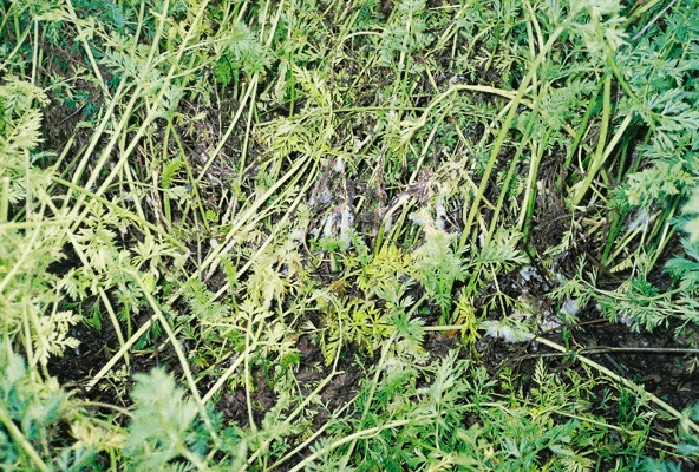
Recent showery weather has encouraged the continuing activity of sclerotia, according to the BASF and ADAS sponsored monitoring system for carrot growers that started in early June. The Sclerotinia monitoring system forms an important part of an integrated management approach that also includes cultural and chemical control measures.
Sclerotinia is a very widespread and serious disease of carrots, affecting both yield and quality and growers should use complementary ways of reducing disease risk by integrating cultural and chemical control methods.
According to Howard Hinds of Howard Hinds Crop Consultancy, a pioneering cultural technique using a specially designed three-bed carrot clipping machine has been developed and used successfully in the UK and in Israel.
“Developed solely in conjunction with BASF and Wroot Water, the canopy clipping technique involves clipping foliage between the rows when the carrot foliage starts to fall over with a new three-bed clipper. The variety Nairobi is particularly prone to flopping over and creating disease risk under lodged foliage. Clipping the foliage allows more air movement in the canopy and disease pressure is reduced. The three-bed clipper follows drilling patterns, and has a speed of operation of up to 10 kms/hour; meaning between 200-300 acres can be clipped per day.”
“We now have three years field experience with this cultural technique and it clearly reduces the Sclerotinia infection by an average of 56%. The use of an effective chemical such as Signum can then be integrated into the control programme.”
Howard points out that the use of the three-bed clipper doesn’t take away the need for a timely fungicide programme but may reduce the need for later fungicide applications. “The way to reduce Sclerotinia is to use an effective fungicide programme in conjunction with cultural control. The first fungicide application, which is normally Signum, is applied when the crop is standing and before it has closed over. The spray should be targeted into the bottom of the crop to cover the soil between the rows.”
The extent of disease risk and fungicide timing is indicated by the ADAS/BASF Sclerotinia Monitoring, which monitors patterns of sclerotial germination each week for ten weeks from June through to August. Growers can check published information on the AgriCentre web site (www.agriCentre.basf.co.uk ).
The most recent ADAS/BASF Sclerotinia Monitoring bulletin indicates that Sclerotinia should kick into action following the recent rain and within two weeks growers should be ready to start treatments, says Dr. Peter Gladders from ADAS Boxworth. “Carrot crops are usually vulnerable to infection by Sclerotinia from June through to October, when the resting bodies or sclerotia germinate. Sclerotia germinate when the soil is moist and soil temperatures are 10°C and above. Growers should start their fungicide applications early, before the canopy closes over, as once Sclerotinia is in the crop it is almost impossible to get on top of it.”
Robert Storer, Field Vegetable Product Manager for BASF, says that, as a protectant fungicide, Signum should be placed at the base of the plant where infection starts and where old leaves come into contact with the ground. “The first Signum spray is recommended before the crop canopy has closed over and the ground is still visible. The Sclerotinia fungus invades diseased, senescing or decaying leaves of the carrot crop, particularly those in contact with the soil. Roots are infected via the leaf petioles and through the crown. So starting the control programme before the canopy closes over is advisable. A closed canopy shields the base of the plant from fungicide sprays.”
“Signum is fully approved in carrots and provides broad-spectrum disease control of Sclerotinia, Alternaria and Powdery mildew. In ADAS trials Signum gave 58% control of Sclerotinia, compared with 5% control for azoxystrobin and 28% control for tebuconazole. For Alternaria, Signum also gave the highest level of control, reducing infection levels to 19% from 55% in the untreated, with azoxystrobin reducing infection down to 30% and tebuconazole to 28%. Where Powdery mildew was the target disease, the untreated suffered 62% infection but Signum reduced this to just 3%, compared with azoxystrobin and difenoconazole resulting in 10% infection,” reports Rob Storer.
